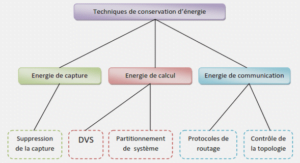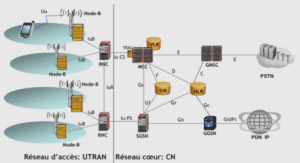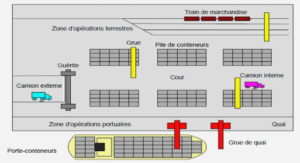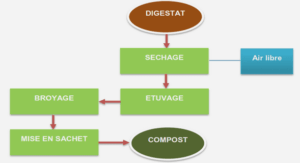L’HYDROFACIÈS DANS LES APPLICATIONS HYDROGÉOLOGIQUES
Beaucoup d’études hydrogéologiques ont utilisé les hydrofaciès pour décrire l’architecture des aquifères. Quatre études ont été examinées et comparées pour étudier certaines utilisations des lithofaciès dans des applications hydrogéologiques.
L’étude de Anderson et al. (1999) avait comme objectif de chercher des moyens de quantifier l’hétérogénéité de l’aquifère. Pour les auteurs de l’étude, une approche sédimentologique est qualitative alors qu’une approche quantitative est hydrogéologique.
La zone d’étude était une large plaine d’épandage mise en place à la fin de la glaciation Wisconsinienne. Onze (11) lithofaciès ont été distingués sur la base de la taille des clastes dominantes, du tri, des structures sédimentaires et des frontières externes. Par la suite, les lithofaciès ont été regroupés en sept (7) hydrofaciès et cartographiés à l’aide de la photomosaïque, de profils de géoradar et de croquis des affleurements réalisés sur le terrain. La conductivité hydraulique des hydrofaciès est basée sur la taille moyenne des grains. Selon les auteurs, c’est le contraste de conductivité hydraulique qui est important et non les valeurs absolues de celle-ci.
Tel que présenté dans la section précédente, Klingbeil et al. (1999) se concentrent sur une méthode de cartographie des affleurements quaternaires en termes de faciès lithologiques et la représentation des ensembles de données à l’égard de propriétés hydrogéologiques. Les vingt-trois (23) lithofaciès identifiés sont classés en cinq faciès différents avec une signification hydrogéologique (hydrofaciès). Ils sont principalement distingués par la granulométrie et la structure : (1) gravier bimodal, (2) gravier à structure ouverte, (3) gravier à stratification horizontale/planaire/auge, (4) gravier massif et (5) sable.
Les hydrofaciès peuvent comprendre différents lithofaciès, mais un type spécifique de lithofaciès ne peut appartenir qu’à un hydrofaciès. Bayer et al. (2011) ont réalisé une cartographie dans une gravière pendant son exploitation. Il a donc été possible d’obtenir une représentation tridimensionnelle des sédiments. Les lithofaciès ont été caractérisés par la taille de grains, le tri, la sphéricité, la composition de particules, la structure et la présence de stratifications. Quatre (4) lithofaciès ont été identifiés : (1) gravier mal trié non jointif (Gcm), (2) gravier alternant avec du sable (Gcg,a), (3) sable et gravier bien trié (GS-x) et (4) sable bien trié et pur (S-x).
Les différents lithofaciès sont par la suite caractérisés en termes de paramètres hydrogéologiques. Les faciès avec une perméabilité et une porosité semblables ont pu être fusionnés. Dans le cas présent, certains lithofaciès (le gravier mal trié et le gravier alternant) ont été subdivisés pour tenir compte des particularités présentes dans chacun des lithofaciès. La nomenclature suit celle des lithofaciès.
Dans l’étude de Ouellon et al. (2008), les hydrofaciès sont définis comme un matériau granulaire avec une taille de grain similaire ainsi que des propriétés hydrauliques et mécaniques similaires. L’hétérogénéité du système aquifère deltaïque de Valcartier (Québec) a été étudiée pour connaître son influence sur le transport d’un contaminant présent dans ce secteur, le trichoroethylène (TCE). L’hétérogénéité est définie par la distribution des hydrofaciès et de la conductivité hydraulique. À partir de la classification du Centre Géoscientifique du Québec (voir section 2.3), les faciès sont regroupés en hydrofaciès numérotés de 1 à 5. Le regroupement final a été fait pour obtenir un nombre suffisant d’observations pour représenter chaque hydrofaciès, ainsi qu’une distribution et une moyenne de la conductivité hydraulique distincte pour chaque hydrofaciès.
Ezzy et al. (2006) ont construit un modèle numérique d’écoulement à partir de la distribution des hydrofaciès identifiés sur le terrain et à l’aide du géoradar. Six (6) hydrofaciès sont étiquetés de A à F sur la base de l’analyse granulométrique, de la comparaison des valeurs de la conductivité hydraulique obtenues à partir d’essais de pompage et des mesures en laboratoire. Ces hydrofaciès ont été ensuite utilisés dans un modèle numérique d’écoulement.
En résumé, pour la majorité des auteurs, les hydrofaciès sont utilisés pour fusionner plusieurs lithofaciès en une unité afin de simplifier la représentation des propriétés hydrauliques des sédiments. Parfois, les hydrofaciès sont utilisés pour délimiter plusieurs propriétés hydrauliques dans un lithofaciès. Cela dépend principalement de l’usage qui est fait de la classification des hydrofaciès et du degré d’hétérogénéité présent. Lettres, chiffres et codes de lithofaciès sont utilisés pour nommer les hydrofaciès. Ces classifications ne nous donnent pas les propriétés hydrogéologiques (conductivité hydraulique et/ou porosité) des hydrofaciès.
PROPOSITION DE CLASSIFICATION DES LITHOFACIES ET HYDROFACIES
La grande problématique dans l’assemblage des hydrofaciès est la correspondance entre les différentes échelles et classifications. L’hydrofaciès se doit d’être homogène en perméabilité, mais pas nécessairement pour ce qui est de la composition du matériel. Étant donné que la majorité des hydrofaciès sont formés à partir des lithofaciès, il faut d’abord normaliser les codes des lithofaciès afin d’obtenir des hydrofaciès cohérents.
LITHOFACIÈS
Pour les lithofaciès, il est reconnu que chacun peut adapter la classification dans le but de faire un classement ajusté pour le type de sédiments présents dans la zone d’étude.
Les lithofaciès peuvent donner une approximation des propriétés hydrauliques des sédiments, mais cette approche est plus qualitative que quantitative. Deux facteurs principaux influencent les propriétés hydrogéologiques dans les sédiments non consolidés: la granulométrie et le tri. Il est donc proposé d’ajouter un indice pour la taille des grains puisque celle-ci est l’une des variables les plus importantes pour caractériser les propriétés hydrogéologiques des sédiments et qu’elle varie souvent à travers un lithofaciès. Les divisions granulométriques sont basées sur le système « Unified Soil Classification System (USCS) » (ASTM, 2011). Le tableau 1 présente la nomenclature/classification des lithofaciès proposés. Un indice (f, m ou g) est ajouté à chaque taille des grains principale (G, S ou F). Ainsi un gravier fin sera Gf, un sable grossier Sg et une argile Ff. Les textures et structures sont par la suite ajoutées. Voici quelques exemples :
HYDROFACIÈS
Le concept d’hydrofaciès peut servir à diverses applications. Principalement, les hydrofaciès sont utilisés pour caractériser les conditions hydrogéologiques de l’environnement étudié; ils sont aussi utilisés en modélisation et simulation numérique de l’écoulement. Dans ce genre d’étude, les hydrofaciès sont utiles pour dresser un portrait de la distribution souterraine des propriétés hydrogéologiques tout en définissant la conductivité hydraulique (K) de ces unités.
L’examen des études utilisant les hydrofaciès a montré que la nomenclature des hydrofaciès n’est pas la même d’une étude à l’autre. C’est un grand contraste avec la nomenclature des lithofaciès, qui est bien développée et adaptée pour de nombreux types de sédiments. Cette nomenclature permet au lecteur d’identifier la lithologie (la granulométrie et la structure) avec un maximum de 3 ou 4 lettres. Plusieurs études utilisent la nomenclature des lithofaciès pour nommer les hydrofaciès. Étant donné que les lithofaciès incluent une composante structurelle, il devient très difficile de définir un lithofaciès lors de travaux destructifs (ex. forage). Il est donc proposé de classer et de nommer les hydrofaciès tout d’abord avec la taille des grains et d’ajouter un indice pour la perméabilité (Tableau 2).
Il serait alors plus facile d’identifier les propriétés hydrogéologiques de l’hydrofaciès qui sont la définition même d’un hydrofaciès.
Les lithofaciès identifiés sur le terrain (notamment dans les sablières et gravières) peuvent difficilement être associés aux identifiants lithologiques provenant de forages destructifs, source principale des données disponibles pour la construction de modèles stratigraphiques. Ainsi, l’utilisation des hydrofaciès lors de la construction de modèles numériques permet de synthétiser l’information en combinant les observations terrains et les données disponibles, en plus de caractériser la nature hydrogéologique des sols.
METHODOLOGIE DE CONSTRUCTION ET DE SIMPLIFICATION HYDROSTRATIGRAPHIQUE
Ce chapitre contient un article intitulé «A hydrostratigraphic simplification approach to build 3D groundwater flow numerical models : example of a Quaternary deltaic deposit aquifer» présente une analyse des effets de simplifications hydrostratigraphique sur la précision de modèle numérique d’écoulement 3D. Il a été publié en date du 29 avril 2015 dans la revue Environnemental Earth Sciences : DOI 10.1007/s12665-015-4439-y.
A hydrostratigraphic simplification approach to build 3D groundwater flow numerical models: example of a Quaternary deltaic deposit aquifer Etienne Hudon-Gagnon, Romain Chesnaux, Pierre A. Cousineau, Alain Rouleau Département des sciences appliquées, Université du Québec à Chicoutimi (UQAC), 555 Boulevard de l’Université, Chicoutimi, Québec, Canada
Abstract
The construction of 3D hydrogeological models for unconsolidated sedimentary aquifers remains particularly challenging, especially in Quaternary deposits. Simplifications at small or large scale are part of groundwater flow modeling and are often required due on the usual inherent complexity of the stratigraphic systems. This study analyses the effects of hydrostratigraphic simplifications on the accuracy of 3D numerical groundwater flow models. Such investigation is conducted from an initial detailed model of an aquifer located in the Saguenay-Lac-St-Jean (SLSJ) region in Canada and the considered simplifications are based on using the equivalent hydraulic conductivity concept. Different levels or approaches of simplification are applied to numerical simulated models and the results of the different scenarios are compared. A Root Mean Square (RMS) calibration result of 3,79 m on the groundwater levels is obtained for the most detailed model, while the RMS ranges between 4,01 m and 4,83 m with the simplified models. Such results illustrate a gain obtained in the calibration of the model with increasing level of hydrostratigraphic details, but that this gain is relatively limited. The proposed methodology for simplifying the hydrostratigraphic settings could be used by hydrogeological modellers for a wide variety of aquifers constituted of sedimentary granular material.
Résumé
La construction de modèles hydrogéologiques 3D pour les aquifères de sédiments non consolidés reste un défi important, particulièrement pour les dépôts quaternaires. Des simplifications, à différents niveaux d’échelles sont nécessaires en modélisation des écoulements souterrains à cause de la complexité des systèmes hydrostratigraphiques. Cette étude s’intéresse à évaluer les effets de simplifications hydrostratigraphiques sur la justesse des modèles numériques d’écoulements d’eau souterraine. Une telle investigation est menée à partir d’un exemple de modèle initial bien détaillé d’un aquifère localisé dans la région du Saguenay-Lac-Saint-Jean (SLSJ) au Canada et les simplifications qui sont ensuite effectuées se basent sur le concept de la conductivité hydraulique équivalente. Différents niveaux de simplifications sont appliqués aux modèles numériques et les résultats obtenus des différents scénarios sont comparés entre eux. Un calage des simulations numériques par l’erreur quadratique moyenne (EQM) conduit à une EQM de 3,79 m sur les charges hydrauliques pour le modèle à plus haut niveau de détail alors que des valeurs comprises entre 4,01 m et 4,83 m sont obtenues pour les modèles simplifiés.
Ces résultats illustrent le fait que le gain obtenu sur la justesse (calage avec l’EQM) des modèles en fonction des degrés de simplifications stratigraphiques qui sont considérés reste limité. La méthodologie qui est proposée pour réaliser les simplifications hydrostratigraphiques pourrait être utilisée par les hydrogéologues praticiens pour un large éventail de contextes d’aquifères granulaires.
Introduction
A significant amount of groundwater resources is located in superficial granular aquifers overlying the bedrock. These aquifers generally consist of bedded sediments (sand, gravel and clay) and they can be very heterogeneous regarding their granular composition as well as their hydraulic conductivity (K). Such heterogeneity obviously plays a major role in controlling the groundwater flow patterns. Therefore, the construction of 3D hydrogeological models for sedimentary aquifers, requiring to detect, to measure and to take into account as much as possible that heterogeneity, remains a major challenge for the modellers.
Using 3D groundwater flow models is now a common practice, even though the reconstruction of the hydrostratigraphic architecture of aquifers is usually not a simple task (Ross et al., 2004). Various tools have been proposed and tested to establish a satisfying hydrostratigraphy for those models, including field observations (Klingbeil et al., 1999; Weissmann et al., 1999) and geophysics (Heinz and Aigner, 2003; Sharpe et al., 2003). However, the community of modellers agrees that a suitable approach for building hydrostructural models should combine and integrate multiple methods of investigation (e.g. sedimentology; geophysics, geochemistry and morphostratigraphy). This multidisciplinarity is necessary in order to detect, identify and delineate the different hydrostratigraphic units. Such holistic approach is largely used for building 3D models by assembling borehole data as well as geophysical data. Although lithological descriptions may vary from one hole to the next and there is no consistent methodology for reconstructing and representing such actual variations, developing models is justified (Allen et al., 2008) as long as the models tend to provide the highest level of representativity of the system.
The scientific community has shown a growing interest in the protection of aquifers (Drew and Hötzl, 1999) since Albinet and Margat (1970) introduced the concept of vulnerability of groundwater. Studies, such as that of Calvache et al. (2009), used numerical modeling as a cost-effective tool to improve the protection of aquifers. The results of numerical models, when properly calibrated on the actual observed data, can be used as a decision-making tool for a proper management of groundwater resources.
The accuracy targeted for a numerical model is directly related to the purpose and the use to be made of the model. For example, a model designed for the simulation of contaminant transport may require a high level of accuracy and therefore may need to be based on a large amount of hydrostratigraphic information. This may be different for a model aimed at regional management purposes, such latter model requiring a lower level of accuracy. However, in any case, numerical groundwater flow models cannot pretend to dress a real picture of the subsurface and hydrogeological processes because they are limited by the efficiency of the investigation tools, their costs and also probably because of our inadequate understanding of the groundwater systems. Consequently, various degree of simplification is required, and this must be conducted in a reasonable and appropriate manner as an integral part of groundwater flow modeling. As recently stated by Doherty (2011) “Learning how to define and locate the optimal compromise between simplicity and complexity is one of the biggest problems facing current modeling practice”.
The main purpose of the presented study consists of analyzing the effects of hydrostratigraphic simplifications on the accuracy of 3D groundwater flow numerical models using the example of a large aquifer constituted of sedimentary granular material.
This site is particularly relevant considering the complexity and the diversity of the nature of the different layers constituting the granular deposits. The simplifications are considered from a detailed hydrostratigraphic model of the aquifer following the equivalent hydraulic conductivity concept (Leonards, 1962). Few studies have used the equivalent hydraulic conductivity concept except Sepúlveda and Kuniansky (2009). Since neither very simple nor very complex models are likely to provide the most accurate predictions (Hill, 2006), it is proposed that the impact of the degree of simplification of a model needs to be investigated by comparing the results obtained using different simplification degrees, in order to define which degree may be satisfying for the modeller. Existing data (obtained from boreholes, consultant reports, digital elevation model, etc.) and new data (obtained from boreholes, outcrop analyses, ground-penetrating radar and particle size analyses) are used to build the detailed model of the Mistouk aquifer in the Saguenay-Lac-Saint-Jean region. The different developed models present a layer-cake geometry where layers are hydrofacies. An hydrofacies is commonly defined as an homogeneous sedimentological unit characterized by its homogenous porosity and permeability but not necessarily isotropic (Anderson, 1989). Using numerical modeling, the results of different levels of simplification are presented and compared. Indeed, the study illustrates how numerical modeling can assess how acceptable a hydrostratigraphic system can be simplified to obtain satisfactory results with limited loss of the actual hydrogeological conditions.
Methodology
Site data collection
In order to construct a numerical 3D groundwater flow model of the Mistouk aquifer, existing data have been gathered and compiled. In addition, extensive fieldworks have been conducted to complete this information and satisfy our needs. LaSalle and Tremblay (1978) established a map of the surficial geology of the Quaternary deposits of the SLSJ region.
However, such map had never been updated and was produced at a scale that is not sufficient for detailed hydrogeological investigations. In 2009-2010, new maps of surficial deposits (Figure 1) of the Saguenay-Lac-Saint-Jean region was realized (Daigneault et al., submitted in 2011) that used the standardized descriptions developed by the Geological Survey of Canada(Parent et al., 2009). In the study area, the map sheet was mainly used to estimate the recharge of the aquifer but also to delineate major units of the model such as the clay.
Borehole stratigraphy is an essential component in the construction of 3D models. In the SLSJ region, the regional project of the Groundwater knowledge acquisition program (Programme d’Acquisition de Connaissances sur les Eaux Souterraines; PACES-SLSJ) has established a groundwater geodatabase of that region after the compilation of existing and new hydrogeological data (Chesnaux et al., 2011). Such a database contains borehole logging and hydraulic testing information, and hydrogeochemical data among other relevant hydrogeological information. A total of 247 stratigraphic records were initially available in and around the Mistouk aquifer (location of the private wells in Figure 2).
3D hydrostructural models construction
An inventory of the lithofacies sequences was carried out to establish the hydrostratigraphy of the aquifer. A compilation of the vertical positions of the facies was conducted to determine their successions and arrangements. Then, the different horizons are defined in each stratigraphic record from defining the positions of the contacts between two different units. Indeed, each horizon is finally extended by kriging interpolation (Matheron, 1969) using the position of the contacts. A Digital Elevation Model (DEM), with a vertical precision of 10 m, is used to model the ground surface (top of the first layer).
After the 3D structural model is established, the hydraulic properties of the different layers of the model must be established. The concept of equivalent hydraulic conductivity adopted by Leonards (1962) is used in this study for testing different scenarios of simplification of the multi-layered system. This method of simplification offers multiple advantages; first the analytical calculation is easy to operate, this method can take into account the anisotropy of layered media such as observed in a paleo-delta and finally this approach allows to take into account the geology of the site by regrouping layers with specific criteria (e.g. source, facies associations/successions or architectural elements). The calculation of the equivalent hydraulic conductivities in the three spatial directions is described in the two following equations (Equations 1 and 2).
Groundwater flow models
Groundwater pumping from private wells is neglected in the regional groundwater flow model developed in this study, considering that these pumping rates are negligible at a regional scale and furthermore, that these values are not accurately known. Consequently, only the pumping rates of the municipal wells have been considered in the models. The Mistouk aquifer has various hydraulic boundaries. The watershed of the Mistouk River is considered to delineate the boundaries of the aquifer given that the surface water divide is often a boundary between groundwater basins (Schwartz and Zhang, 2003). However, two modifications are made in regard to the hydrostratigraphic configuration. Firstly, the northern limit of the aquifer was stretched to the Péribonka River since the aquifer is certainly connected to this river (Dessureault, 1975). Secondly, the western limit of the aquifer was positioned along the Kenogami Uplands because the bedrock is taken as an impermeable limit considering the high contrast of hydraulic conductivity between the crystalline rock and the non-cohesive granular deposits.
A number of hydrogeological consulting reports covering parts of this sector are available and easily accessible, since the towns in the region use groundwater as a source of drinking water supply. These reports constitute an important source of information regarding the hydraulic conductivity (obtained from pumping tests and permeability tests) as well as regarding the hydrofacies. These data are integrated as input information to construct the model. In order to complete the information on the hydraulic properties of the aquifer, the grain-size curves of the samples collected from the surface and drill hole have been used to estimate the hydraulic conductivity using different empirical formulas (Hazen, 1911; Beyer, 1964; NAVFAC, 1974; Chapuis, 2004). Such collection of samples is important because it allows determining the hydraulic conductivity profiles considering the different layers identified during borehole logging.
After filtering groundwater static levels from the database (removing those that were measured in the bedrock), the remaining water table elevations are incorporated into the numerical model. These observation points (67 points) are used for the calibration of the groundwater flow model when comparing the observed actual water table levels with the simulated levels.
|
Table des matières
REMERCIEMENTS
TABLE DES MATIÈRES
LISTE DES FIGURES
CHAPITRE 1 : INTRODUCTION
1.1 PROBLÉMATIQUE GÉNÉRALE
1.2 PROBLÉMATIQUES SPÉCIFIQUES
1.3 OBJECTIFS
1.4 MÉTHODOLOGIE
CHAPITRE 2 : CLASSIFICATION DES HYDROFACIÈS
2.1 FACIES, LITHOFACIES ET HYDROFACIES
2.2 ÉCHELLES GRANULOMÉTRIQUES
2.3 LE LITHOFACIÈS DANS LES APPLICATIONS HYDROGÉOLOGIQUES
2.4 L’HYDROFACIÈS DANS LES APPLICATIONS HYDROGÉOLOGIQUES
2.5 PROPOSITION DE CLASSIFICATION DES LITHOFACIES ET HYDROFACIES
2.5.1 LITHOFACIÈS
2.5.2 HYDROFACIÈS
CHAPITRE 3 : METHODOLOGIE DE CONSTRUCTION ET DE SIMPLIFICATION HYDROSTRATIGRAPHIQUE
INTRODUCTION
STUDY SITE
METHODOLOGY
THE DIFFERENT HYDROSTRATIGRAPHIC MODELS
COMPARISON OF THE NUMERICAL RESULTS OF THE FIVE DIFFERENT MODELS
REGIONAL GROUNDWATER FLOW
DISCUSSION AND CONCLUSION
CHAPITRE 4 : CONCLUSION
RÉFÉRENCES
ANNEXE 1
GLOSSAIRE
ANNEXE 2
DONNÉES PIÉZOCONES
![]() Télécharger le rapport complet
Télécharger le rapport complet






